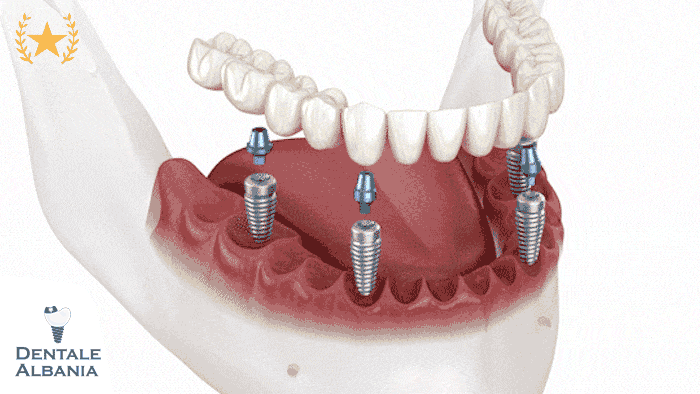Table of Contents
ToggleWhat Are Dental Implants and How Do They Work?

Dental implants are a modern, long-term solution for replacing missing teeth, offering both functional and aesthetic benefits. They consist of titanium posts surgically placed into the jawbone, acting as artificial tooth roots. These implants support crowns, bridges, or dentures, providing a durable and natural-looking replacement for lost teeth.
What Is an Implant in Dentistry?
- A dental implant is a small, screw-like post, usually made of titanium, inserted into the jawbone to replace the root of a missing tooth.
- The implant fuses with the bone in a process called osseointegration, ensuring stability and longevity.
- Once healed, an abutment and a prosthetic tooth (crown) are attached to complete the restoration.
What Are the Different Types of Dental Implants?
- Single tooth implants: Ideal for replacing a single missing tooth with a custom-made crown.
- Implant-supported bridges: Used when multiple adjacent teeth are missing, distributing pressure evenly across the implants.
- All-on-4 and All-on-6 implants: Full-arch solutions for patients missing most or all of their teeth, reducing the number of implants needed for full-mouth restoration.
- Mini dental implants (small-diameter implants): A less invasive option for those with insufficient bone for standard implants.
- Zygomatic implants: An advanced option for individuals with severe bone loss, anchoring into the cheekbone instead of the jawbone.
How Do Dental Implants Work?
- The implant post is surgically placed into the jawbone, replacing the natural tooth root.
- Over the next few months, the implant integrates with the bone, creating a stable foundation.
- Once healed, an abutment is attached, followed by a custom-designed crown or bridge.
- The result is a natural-looking and fully functional tooth replacement that mimics real teeth in both appearance and function.
This section provides a comprehensive introduction to dental implants, ensuring it includes essential keywords like what is an implant in dentistry, what is a dental implant, what is an implant tooth, and how do dental implants work in a natural and informative way. The following sections will delve into the procedure, costs, risks, recovery, and alternatives to dental implants.
What Is the Procedure for Getting Dental Implants?
The dental implant process involves several stages, requiring meticulous planning and precision to ensure long-term success. The procedure typically takes place over several months, allowing time for healing and osseointegration.
What Are the Steps in the Dental Implant Process?
- Initial Consultation and Examination:
- A dentist evaluates your oral health through X-rays, 3D scans, and medical history.
- Bone density and gum health are assessed to determine implant eligibility.
- Tooth Extraction (If Needed):
- If a damaged tooth is still present, it must be removed before implant placement.
- In some cases, an implant can be placed immediately after extraction.
- Bone Grafting (If Necessary):
- If the jawbone lacks sufficient density, a bone graft may be required to reinforce the implant site.
- Healing from a bone graft can take several months before implant placement.
- Surgical Implant Placement:
- The implant is surgically inserted into the jawbone under local anesthesia or sedation.
- A healing cap may be placed to protect the implant while the bone fuses around it.
- Osseointegration Phase:
- Over 3 to 6 months, the implant integrates with the jawbone, creating a stable foundation.
- Abutment Placement:
- Once healed, a small connector (abutment) is attached to the implant to hold the prosthetic tooth.
- Crown or Prosthetic Tooth Placement:
- A custom-made crown, bridge, or denture is fixed onto the abutment.
- The result is a fully functional and natural-looking tooth replacement.
What Are the Different Surgical Approaches for Implants?
- Single-stage surgery: The implant and abutment are placed simultaneously, reducing overall healing time.
- Two-stage surgery: The implant is placed first, then covered with gum tissue for healing before the abutment is attached later.
- Immediate load implants: Some patients qualify for same-day teeth, where the implant and crown are placed in a single visit.
By understanding the dental implants process, implantation dentistry, surgical dental implants, and implant dental procedures, patients can better prepare for the treatment. The next section will discuss costs, recovery, and potential risks associated with dental implants.
How Do Dental Implants Work?
Dental implants function as artificial tooth roots that provide a strong, long-lasting foundation for replacement teeth. They are surgically inserted into the jawbone, where they integrate with the bone to create a stable base for prosthetic teeth such as crowns, bridges, or dentures. This process mimics the natural function of a tooth root, making implants the most effective and durable tooth replacement solution.
What Makes Dental Implants a Secure and Long-Term Solution?
- Osseointegration – The Key to Stability:
- Dental implants are made of biocompatible materials, usually titanium, allowing them to fuse with the jawbone.
- This fusion process, called osseointegration, takes a few months but ensures that the implant remains firmly anchored.
- Unlike dentures, implants do not slip or shift, providing a secure and permanent solution.
- Natural Function and Appearance:
- Implants look and function like natural teeth, allowing for normal chewing and speaking.
- Unlike traditional bridges, they do not require support from adjacent teeth, preserving overall dental health.
- Strength and Durability:
- With proper care, dental implants can last for decades, making them a cost-effective long-term investment.
- They withstand normal biting and chewing forces, offering greater reliability compared to other tooth replacement options.
What Are the Different Types of Dental Implants?
- Endosteal Implants: The most common type, placed directly into the jawbone. These serve as a base for crowns, bridges, or dentures.
- Subperiosteal Implants: Positioned on top of the jawbone but beneath the gum tissue, used when there is insufficient bone for traditional implants.
- Zygomatic Implants: A specialized type of implant anchored in the cheekbone for patients with severe bone loss in the upper jaw.
How Do Dental Implants Compare to Other Tooth Replacement Options?
- Implants vs. Dentures: Unlike dentures, implants are fixed and do not require adhesives or daily removal. They also prevent bone loss.
- Implants vs. Bridges: Implants do not rely on adjacent teeth for support, reducing the risk of damage to surrounding healthy teeth.
- Implants vs. Tooth Transplants: A dental implant is a more predictable and reliable solution than a natural tooth transplant, which is only viable in limited cases.
Who Is a Good Candidate for Dental Implants?
Not everyone is automatically eligible for dental implants. While they are a highly effective tooth replacement option, certain factors determine whether a patient is a suitable candidate. A comprehensive dental evaluation is essential to assess bone density, oral health, and overall medical history.
What Are the Basic Requirements for Dental Implants?
- Good Oral Health:
- Healthy gums free from severe periodontal disease are crucial for successful implantation.
- Dental implants require a strong foundation, and untreated gum infections can compromise the integration process.
- Adequate Bone Density:
- Since implants fuse with the jawbone through osseointegration, sufficient bone mass is required to support the implant.
- Patients with bone loss may require additional procedures like a bone graft or sinus lift to improve bone volume.
- Commitment to Oral Hygiene:
- Proper aftercare and regular dental check-ups are necessary to maintain dental implants.
- Poor oral hygiene increases the risk of peri-implantitis, an infection that can lead to implant failure.
Who Should Avoid Dental Implants?
Some individuals may not be ideal candidates for implant dentistry due to certain medical or lifestyle factors.
- Who isn’t a good candidate for dental implants?
- Heavy smokers: Smoking slows healing and increases the risk of implant failure.
- Uncontrolled diabetes: Poorly managed diabetes can affect healing and increase the likelihood of infection.
- Patients undergoing radiation therapy: Radiation to the head or neck area can impact bone healing and integration.
- People with severe osteoporosis: A lack of bone density can make implant placement challenging.
- When are dental implants not recommended?
- If a patient has severe gum disease or untreated tooth infections, implants may not be immediately viable.
- Those with autoimmune diseases or conditions that affect healing may face increased complications.
How Bad Do Teeth Need to Be to Get Implants?
- If a tooth is severely damaged, decayed, or missing, dental implants may be a recommended solution.
- In cases of multiple missing teeth, full-mouth restoration options such as All-on-4 or implant-supported overdentures may be considered.
- If a tooth is salvageable through root canal treatment or a crown, an implant may not be necessary.
What If I Have Insufficient Bone for Implants?
Patients with bone loss can still qualify for dental implants with additional procedures, such as:
- Bone grafting: Adding bone material to strengthen the implant site.
- Sinus lift: Raising the sinus floor to allow for implant placement in the upper jaw.
- Zygomatic implants: Using the cheekbone instead of the jawbone for support in cases of severe bone loss.
Are There Risks and Complications With Dental Implants?
Dental implants have a high success rate, often exceeding 95%, but like any surgical procedure, they come with potential risks and complications. While most issues can be managed with proper planning and care, it’s crucial to be aware of the possible challenges that may arise before, during, or after the implant surgery.
What Are the Common Risks of Dental Implants?
- Implant Failure
- In some cases, dental implants may fail to integrate with the jawbone, a process called osseointegration.
- Factors that contribute to implant failure include poor bone density, smoking, uncontrolled diabetes, and infection.
- Infection (Peri-Implantitis)
- One of the most common dental implant complications is peri-implantitis, an infection that affects the soft and hard tissues surrounding the implant.
- Poor oral hygiene, smoking, and pre-existing gum disease increase the risk of peri-implantitis.
- Symptoms include swelling, bleeding, pus, pain, and potential bone loss around the implant site.
- Nerve Damage
- If an implant is placed too close to a nerve, it can cause numbness, tingling, or pain in the surrounding area.
- This complication is rare but can happen if the implant dentist does not properly assess nerve positioning before implant placement.
- Sinus Problems
- Implants in the upper jaw may protrude into the sinus cavity, causing discomfort or sinus infections.
- A sinus lift may be necessary for patients with insufficient bone height in the upper jaw.
- Bone Loss Around the Implant
- Over time, some patients may experience bone loss, leading to implant instability.
- This can be due to excessive bite pressure, untreated gum disease, or poor oral hygiene.
Can Your Body Reject Dental Implants?
While dental implants are made from biocompatible titanium, meaning they are designed to integrate with the body, implant rejection can still occur.
- Signs of rejection or failure:
- Persistent pain or discomfort after the healing period.
- Implant mobility or loosening.
- Gum recession around the implant.
- Swelling, infection, or pus formation.
- Risk factors for implant rejection:
- Patients with autoimmune disorders may be at a higher risk.
- Smoking and excessive alcohol consumption can slow healing.
- Poor bone quality or insufficient healing time before placing the final prosthetic.
What Don’t They Tell You About Dental Implants?
While dental implants are often advertised as a permanent solution, certain lesser-known facts should be considered:
- Healing time varies – It can take 3 to 6 months for the implant to fully integrate with the bone.
- Additional procedures may be needed – Bone grafts, sinus lifts, or gum treatments may be required before getting dental implants.
- Long-term maintenance is essential – Just like natural teeth, implants need to be cleaned regularly to prevent plaque buildup and potential complications.
How Common Are Problems With Dental Implants?
- The majority of dental implant procedures are successful, but complications can arise in 5-10% of cases.
- Most issues can be treated with early intervention, such as antibiotics for infections or adjustments for bite-related discomfort.
- Regular check-ups with a dental implant specialist help detect and address any issues before they become serious.
Understanding these risks and taking preventive measures can ensure the long-term success of dental implants. The next section will cover the costs associated with dental implant surgery and available payment options.
How Much Do Dental Implants Cost?

The cost of dental implants varies significantly depending on several factors, including the type of implant, the number of implants needed, the location of the clinic, and any additional procedures required. Dental implant costs can range from a few hundred to several thousand pounds per tooth, making them a significant investment in long-term oral health.
What Is the Cost of a Single Dental Implant in the UK?
The cost of a single dental implant in the UK generally ranges between £1,500 to £2,500, but this can vary based on:
- The quality of the implant materials (titanium vs. zirconia).
- The expertise of the dentist performing the implant surgery.
- The need for additional procedures, such as a bone graft or sinus lift.
What Is the Cost of a Single Dental Implant in Albania?
Albania has quickly become one of Europe’s top destinations for dental tourism, offering world-class dental implant procedures at significantly lower costs than countries like the UK, US, or Germany. For patients seeking high-quality care without the heavy price tag, Albania provides a cost-effective and reliable solution—especially when it comes to single dental implants.
-
Average Price Range: The cost of a single dental implant in Albania typically ranges between €400 and €800. This includes the titanium implant post, abutment, and crown. Comparatively, the same treatment can cost between €1,800 and €3,000 in Western Europe or up to $5,000 in the United States.
-
Factors That Influence the Cost:
-
The brand of the implant (e.g., Straumann, Nobel Biocare, or more affordable options).
-
Type of crown used (zirconia vs. porcelain-fused-to-metal).
-
Whether bone grafting or sinus lift is needed before placement.
-
The clinic’s reputation and technology level.
-
The experience and specialization of the implantologist.
-
-
Inclusions in the Quoted Price: In most Albanian clinics, quoted prices are often comprehensive. They usually include:
-
Consultation and digital x-rays or CBCT scans.
-
Surgical placement of the dental implant.
-
Temporary crown (if needed).
-
Final permanent crown.
-
Post-operative care and check-ups.
-
-
Cost Transparency and Packages: Albanian dental clinics are known for offering transparent pricing and all-inclusive packages. Some clinics even provide full treatment plans in advance, covering all potential additional costs such as anesthesia, medications, and travel assistance.
-
Travel and Accommodation Savings: Even when factoring in travel and accommodation, patients from abroad often save 50–70% compared to having the procedure done locally. Many clinics offer free airport pick-up, hotel partnerships, or even complimentary accommodation for patients undergoing multiple treatments.
-
Value for Money: Albania’s dental clinics use European-standard materials and operate under EU-compliant hygiene protocols. Despite the lower prices, patients can expect results equal to or better than those in their home countries—making it a destination where affordability does not mean sacrificing quality.
How Much for Full Dental Implants in the UK?
For patients requiring full mouth dental implants, costs can be significantly higher. Common full-arch implant options include:
- All-on-4 implants: Typically range from £8,000 to £15,000 per arch.
- All-on-6 implants: Cost around £12,000 to £20,000 per arch.
- Full mouth reconstruction (both upper and lower arches): Can cost anywhere from £20,000 to £40,000.
How Much for Full Dental Implants in Turkey?
Many patients seek dental implant treatment abroad, particularly in countries like Turkey, where the costs are often lower.
- Single dental implant in Turkey: Around £400 to £800, compared to £1,500+ in the UK.
- All-on-4 dental implants in Turkey: Typically range from £3,000 to £6,000, significantly lower than UK prices.
While dental implants in Turkey are more affordable, patients must carefully consider factors such as clinic reputation, dentist qualifications, and post-treatment care when seeking treatment abroad.
How Much for Full Dental Implants in Albania?
When it comes to full mouth dental restorations, Albania has emerged as a leading destination for affordable, high-quality treatments. Patients from across Europe and even further afield are increasingly choosing Albania for full dental implants due to the country’s significant cost advantages, modern clinics, and experienced implant specialists.
-
Average Cost Range: The price for full dental implants in Albania typically ranges from €3,500 to €7,000 per arch, depending on the treatment type. A full mouth restoration (both upper and lower jaws) generally falls between €6,500 and €13,000, which is up to 70% less than what’s charged in the UK, US, or Germany.
-
Treatment Options and Their Costs:
-
All-on-4 (Acrylic Bridge): Around €3,500–€5,500 per arch.
-
All-on-6 (Porcelain/Zirconia Bridge): Typically €5,500–€7,000 per arch.
-
All-on-8 or Full-Mouth Implants (Zirconia Bridgework): Can range from €7,500–€13,000 depending on material and complexity.
-
Removable Implant-Supported Dentures: A more economical option starting from €3,000.
-
-
What’s Included in the Cost:
-
Comprehensive consultation and diagnostics (including panoramic X-rays or CBCT scans).
-
Surgical procedures (implants placement, extractions if necessary).
-
Temporary fixed teeth during healing.
-
Final prosthesis (zirconia, porcelain, or acrylic bridge depending on plan).
-
Follow-up appointments and post-op care.
-
-
Factors That Influence the Price:
-
Number of implants required (All-on-4 vs. All-on-6 or All-on-8).
-
Bone grafting or sinus lift requirements.
-
Choice of prosthetic materials (acrylic, porcelain, zirconia).
-
Clinic’s location and reputation.
-
Specialist experience and equipment used.
-
-
Transparent and All-Inclusive Packages: Many Albanian clinics offer dental tourism packages that bundle treatment with accommodation, airport transfers, and translation services, making the experience seamless for international patients.
-
Long-Term Value: While the initial investment in full dental implants is significant, they offer lasting results—restoring full bite function, improving facial aesthetics, and enhancing quality of life. Albanian clinics often provide warranty coverage and follow-up support, ensuring peace of mind even after returning home.
Are There Affordable Payment Plans for Dental Implants?
Since dental implant procedures can be expensive, many clinics offer affordable dental implant payment plans, including:
- 0% APR financing options that allow patients to spread the cost over several months.
- Dental insurance coverage (though many policies only partially cover implants).
- Monthly payment options, such as dental implants in London from £23 per month.
Why Are Dental Implants So Expensive?
Several factors contribute to the high cost of dental implants, including:
- Surgical expertise and technology: Implants require precise placement using advanced imaging and guided surgery techniques.
- Material quality: High-grade titanium or zirconia implants are biocompatible and designed to last a lifetime.
- Customization and prosthetics: Each dental crown, bridge, or overdenture is custom-made to fit the patient’s mouth perfectly.
- Additional procedures: Some patients need bone grafting, sinus lifts, or soft tissue grafts, which increase costs.
Although dental implants are a significant investment, they provide a long-term, durable, and natural-looking solution for missing teeth. The next section will explore different types of implants and their benefits.
What Are the Different Types of Dental Implants?
Dental implants come in various types, each designed to meet specific patient needs, bone structure, and oral health conditions. The main factors that differentiate dental implants include their placement, size, and material, as well as whether they support single teeth, multiple teeth, or full arches.
What Are the Main Types of Dental Implants?
The most common types of dental implants include:
- Endosteal Implants: The most commonly used implants, placed directly into the jawbone. They consist of a titanium screw, an abutment, and a dental crown.
- Subperiosteal Implants: Positioned on top of the jawbone but beneath the gum tissue, ideal for patients with insufficient bone density who cannot undergo bone grafting.
- Zygomatic Implants: A more complex option, placed in the cheekbone (zygomatic bone) rather than the jaw, used for patients with severe bone loss.
- Mini Dental Implants (MDIs): Also known as small-diameter implants, these are thinner and used for implant-supported overdentures or cases where a full-size implant is not possible.
What Are Single Tooth vs. Multiple Tooth Implants?
Depending on the number of missing teeth, different implant solutions can be used:
- Single Tooth Implant:
- Used when only one tooth replacement is needed.
- Consists of a single implant post and a dental crown.
- Provides a natural look and function, preventing bone loss.
- Implant-Supported Bridges:
- Used when multiple adjacent teeth are missing.
- Instead of replacing every tooth with an implant, two or more implants support a fixed bridge.
- More cost-effective than placing multiple single implants.
- All-on-4 and All-on-6 Implants:
- All-on-4 implants use four implants per arch to support a full set of teeth.
- All-on-6 implants provide additional support for better stability.
- Both are great solutions for full mouth restoration, offering a fixed, non-removable alternative to dentures.
What Are Full Mouth Dental Implants?
For patients with severe tooth loss, full-mouth dental implant solutions include:
- Full-arch implant restoration: A set of fixed teeth supported by four to eight implants in each jaw.
- All-on-8 implants: Use eight implants per arch for maximum stability and longevity.
- Implant-Supported Overdentures: Also known as denture implants, these snap onto two to four implants, providing removability and better retention compared to traditional dentures.
How Do Different Implant Materials Affect the Results?
- Titanium implants:
- Most commonly used due to biocompatibility and high success rates.
- Strong, durable, and integrates well with the bone (osseointegration).
- Zirconia implants:
- A metal-free alternative for patients with titanium allergies or concerns about metal exposure.
- Naturally white, making them more aesthetic for front tooth replacements.
Each type of dental implant serves a specific purpose, and the right choice depends on bone density, oral health, and budget. A consultation with a specialist implant dentist will help determine the best solution for each patient’s needs.
How Long Does It Take to Recover From a Dental Implant?
The recovery timeline for dental implants varies depending on the patient’s overall health, bone quality, and the complexity of the procedure. While some people heal quickly, others may experience a more extended recovery process, especially if additional treatments such as bone grafting or sinus lifts are required.
What Is the Typical Healing Timeline for Dental Implants?
The dental implant recovery process consists of multiple stages, each with its own timeframe:
- Immediate Post-Surgery (First 24–48 Hours)
- Swelling, minor bleeding, and discomfort are common.
- Pain can be managed with prescribed or over-the-counter pain relievers.
- Eating soft foods and avoiding strenuous activity is recommended.
- First Week After Surgery
- Swelling and bruising usually peak around day 2 or 3 but gradually improve.
- Stitches (if non-dissolvable) may need to be removed after 7–10 days.
- Most patients can resume normal daily activities after the first week.
- Osseointegration Period (3–6 Months)
- This is the most critical phase where the implant fuses with the jawbone.
- Full healing depends on factors like bone density, oral hygiene, and lifestyle habits (e.g., smoking can delay healing).
- Regular dental check-ups are necessary to monitor progress.
- Final Prosthesis Placement (After 3–6 Months)
- Once the implant has fully integrated, the abutment and crown are placed.
- This is when the patient can enjoy a fully functional and natural-looking tooth.
What Factors Affect Dental Implant Healing Time?
Several factors can speed up or slow down recovery:
- Bone density: Patients with strong jawbones heal faster than those who require bone grafting.
- Oral hygiene: Proper care, including gentle brushing and avoiding infection, promotes faster healing.
- Smoking and alcohol use: These habits slow down blood flow and bone integration.
- Underlying health conditions: Diabetes, osteoporosis, and autoimmune disorders can prolong healing.
- Number of implants placed: A single tooth implant heals faster than full-mouth dental implants.
Are There Ways to Speed Up Healing After Dental Implant Surgery?
Patients can optimize their recovery by following these guidelines:
- Stick to a soft food diet (soups, mashed potatoes, yogurt) for the first few weeks.
- Avoid smoking and alcohol, as they delay healing.
- Maintain excellent oral hygiene without disturbing the implant site.
- Follow all post-operative care instructions provided by the dentist.
Are Dental Implants Painful?

One of the most common concerns among patients considering dental implants is whether the procedure is painful. While dental implant surgery is a surgical procedure, modern techniques, anesthesia, and post-operative care make it much more comfortable than many expect. Understanding the pain levels at different stages and how to manage discomfort can help alleviate fears associated with the procedure.
Does Getting a Dental Implant Hurt?
During the dental implant procedure, patients are typically given local anesthesia, meaning the area will be numb, and they should feel little to no pain during the surgery. Some clinics also offer sedation dentistry or general anesthesia for patients who experience dental anxiety or are undergoing complex procedures.
- Local anesthesia: Used for most implant procedures, ensuring a pain-free experience.
- Sedation dentistry: Available for patients who prefer to be in a relaxed state.
- General anesthesia: Used in rare cases, such as full-mouth dental implants.
Most patients report feeling pressure or vibrations during the procedure but no actual pain. The surgeon’s skill level and advanced surgical techniques also play a role in making the experience more comfortable.
How Painful Is the Recovery After Dental Implant Surgery?
Once the anesthesia wears off, some level of discomfort is normal, especially in the first 24 to 72 hours after surgery. The intensity of pain depends on factors such as the number of implants placed, whether bone grafting was needed, and individual pain tolerance.
Common post-surgery sensations include:
- Mild to moderate soreness at the implant site.
- Swelling and bruising around the gums and jawline.
- Minor bleeding in the first few hours.
- Tightness or pressure in the jaw.
However, the pain is usually manageable and subsides within a few days. Most patients report that the discomfort is less severe than tooth extraction.
How Can You Manage Pain After a Dental Implant?
To ensure a comfortable recovery, dentists recommend several pain management strategies:
- Over-the-counter pain relievers: Ibuprofen or acetaminophen helps reduce pain and inflammation.
- Cold compress: Applying ice packs for 10-15 minutes at a time minimizes swelling.
- Soft diet: Avoiding hard or spicy foods prevents irritation at the implant site.
- Proper oral hygiene: Using a prescribed mouth rinse and gentle brushing helps prevent infection.
- Rest and hydration: Getting adequate rest and drinking plenty of water aids in faster healing.
By following post-operative care instructions, most patients find that the pain is short-lived, and discomfort is greatly reduced within 3-5 days.
How Long Does Pain Last After Getting a Dental Implant?
The majority of discomfort subsides within the first week, but minor soreness may persist for a few weeks as the gums heal and the implant integrates with the jawbone. However, chronic or severe pain beyond 2-3 weeks could indicate complications, such as:
- Infection at the implant site (peri-implantitis).
- Improper placement of the implant.
- Nerve irritation or damage (very rare).
If pain worsens or persists beyond a few weeks, it’s crucial to contact the dentist immediately for evaluation.
Is Getting a Dental Implant More Painful Than a Tooth Extraction?
Many patients find that getting a dental implant is less painful than having a tooth removed. While tooth extractions involve removing an already damaged or infected tooth, an implant is placed into a clean, prepared site, which often results in less post-operative discomfort.
Final Thoughts: Should You Worry About Pain During a Dental Implant?
While dental implant surgery involves a healing period, modern techniques and pain management ensure that it is a comfortable and predictable process. Most patients experience only mild to moderate discomfort, and with proper care, pain subsides quickly. If you’re worried about pain, speak with your implant dentist about sedation options and what to expect at each stage of the procedure.
What Are the Alternatives to Dental Implants?
While dental implants are considered one of the best solutions for tooth replacement, they may not be the right option for everyone. Factors such as cost, health conditions, bone density, and personal preference can lead patients to explore alternative options. Fortunately, several effective dental treatments can restore function and aesthetics to your smile.
1. Dentures: A Traditional and Affordable Alternative
Dentures are a well-known and cost-effective alternative to dental implants. They come in two main types:
- Complete dentures: Used when all teeth are missing in the upper or lower jaw.
- Partial dentures: Used when some natural teeth remain, filling in the gaps.
Pros of dentures:
- More affordable than implants.
- No surgery is required.
- Can be adjusted or replaced as needed.
Cons of dentures:
- May become loose over time, requiring adhesives.
- Can cause discomfort or sore spots.
- Do not prevent jawbone loss like implants do.
For patients looking for a non-invasive, lower-cost solution, dentures remain a popular choice.
2. Dental Bridges: A Fixed and Functional Option
A dental bridge is another common alternative to dental implants, used to replace one or multiple missing teeth by anchoring a prosthetic tooth between two natural teeth.
Types of dental bridges:
- Traditional bridges: Held in place by dental crowns on adjacent teeth.
- Cantilever bridges: Anchored to just one adjacent tooth.
- Maryland bridges: Bonded to natural teeth with metal or porcelain wings.
Pros of dental bridges:
- More secure than removable dentures.
- No need for bone grafting.
- Faster procedure compared to implants.
Cons of dental bridges:
- Requires modifying healthy teeth for support.
- Not as long-lasting as implants.
- Does not prevent bone deterioration in the jaw.
Bridges are a good middle-ground option for patients who want a permanent solution without undergoing implant surgery.
3. Tooth-Supported Bridges: A Conservative Alternative
A tooth-supported bridge uses existing healthy teeth as anchors instead of implants or metal frameworks.
Pros:
- Less invasive than implants.
- Provides a stable, long-term solution.
- More affordable than implant-supported options.
Cons:
- Involves filing down adjacent teeth.
- Does not prevent jawbone loss.
- May weaken the supporting teeth over time.
This method is suitable for those with strong, healthy teeth adjacent to the missing tooth.
4. Resin-Bonded Bridges: A Minimally Invasive Option
A resin-bonded bridge, also known as a Maryland bridge, is a conservative alternative that does not require modifying adjacent teeth extensively.
Pros:
- Less invasive than traditional bridges.
- A good option for replacing front teeth.
- Quick and cost-effective.
Cons:
- Less durable than implants or traditional bridges.
- May not withstand the pressure of chewing.
- Can come loose over time.
Resin-bonded bridges are best suited for replacing front teeth where minimal chewing force is applied.
5. Removable Partial Dentures: A Temporary Solution
For patients who need a non-permanent option, removable partial dentures can be used to replace multiple missing teeth without surgery.
Pros:
- Less expensive than implants or fixed bridges.
- No surgery or tooth preparation required.
- Can be adjusted or replaced easily.
Cons:
- Less stable and comfortable than other alternatives.
- May cause gum irritation.
- Must be removed daily for cleaning.
Partial dentures are often recommended for patients who need a temporary tooth replacement before considering implants or bridges.
6. Flipper Tooth: A Quick Fix for Missing Teeth
A flipper tooth is a temporary, lightweight denture that fills in gaps where teeth are missing.
Pros:
- Inexpensive and quick to make.
- Easily removable.
- No impact on existing teeth.
Cons:
- Not a long-term solution.
- Less durable and can break easily.
- May feel uncomfortable over time.
Flipper teeth are typically used as a temporary measure while waiting for a permanent restoration.
7. Orthodontic Solutions for Minor Gaps
In some cases, orthodontic treatments like braces or clear aligners can be used to close small gaps left by missing teeth.
Pros:
- Non-surgical.
- Helps improve bite alignment.
- Preserves natural teeth.
Cons:
- Not suitable for larger gaps.
- Takes time to achieve results.
- May require additional treatments.
Orthodontic solutions work best for minor gaps, but they are not an alternative for replacing entire missing teeth.
Which Alternative Is Right for You?
Choosing an alternative to dental implants depends on your oral health, budget, and long-term goals. Dentures and bridges offer practical, cost-effective solutions, while more advanced treatments like resin-bonded bridges or orthodontic approaches may be beneficial for specific cases.
If you’re considering dental implants or alternatives, consulting with a dental professional can help determine the best solution for your needs.
How to Take Care of Dental Implants?

Proper dental implant care is essential for ensuring long-term success and durability. Unlike natural teeth, implants do not decay, but they still require maintenance to prevent complications like peri-implantitis, gum disease, and bone loss. Below are key steps to maintaining healthy and long-lasting dental implants.
1. Daily Oral Hygiene for Dental Implants
Just like natural teeth, dental implants require a consistent oral hygiene routine to prevent plaque buildup and gum infections.
Best practices for implant hygiene:
- Brush twice a day using a soft-bristled toothbrush to avoid damaging the implant surface.
- Use low-abrasive toothpaste to prevent scratching the implant crown.
- Floss daily with implant-specific floss or interdental brushes to clean around the implant and gum line.
- Use antimicrobial mouthwash to reduce bacteria and inflammation.
- Avoid hard-bristled toothbrushes and harsh whitening toothpaste, which can damage the restoration.
A good oral care routine ensures dental implants remain clean, functional, and free from bacterial infections.
2. Professional Cleanings and Dental Checkups
Regular dental checkups and professional cleanings are critical for monitoring implant health and preventing complications.
How often should you visit the dentist?
- Every 3 to 6 months for professional cleanings.
- Annual X-rays to check for any bone loss or implant movement.
- Routine implant assessments to monitor gum health and detect early signs of complications.
During these visits, dentists use special instruments to clean around implants without scratching the surface, ensuring optimal longevity.
3. Avoiding Harmful Habits
Certain lifestyle habits can affect the longevity of dental implants, leading to damage or implant failure.
Habits to avoid:
- Smoking – Increases the risk of implant failure and gum disease.
- Chewing hard foods – Ice, hard candies, or nuts can crack or loosen the implant crown.
- Bruxism (teeth grinding) – Can cause excessive pressure on the implant, leading to complications.
- Using teeth as tools – Avoid opening bottles or packages with your implants.
By eliminating harmful habits, patients can extend the lifespan of their dental implants.
4. Diet and Nutrition for Healthy Implants
A balanced diet plays a significant role in maintaining healthy gums and strong bones, which support dental implants.
Nutritional tips for implant health:
- Eat calcium-rich foods (dairy, leafy greens) to strengthen the jawbone.
- Increase Vitamin D intake to aid bone healing.
- Limit sugary and acidic foods to prevent gum inflammation.
- Stay hydrated to support saliva production, which helps fight bacteria.
A healthy diet ensures the long-term success of dental implants by promoting strong bones and healthy gums.
5. Managing Dental Implant Sensitivity and Discomfort
Some patients experience sensitivity or mild discomfort after dental implant surgery or during their daily routine.
Ways to reduce sensitivity:
- Use a sensitive-teeth toothpaste.
- Avoid extreme hot or cold foods.
- Stick to a soft food diet in the early recovery phase.
- Follow dentist recommendations for pain management.
If discomfort persists, consult a dental professional to rule out any underlying issues.
6. Recognizing Signs of Dental Implant Problems
Even with proper care, complications can arise. It’s important to recognize early warning signs of implant issues.
Signs of dental implant problems:
- Persistent gum inflammation or bleeding (possible peri-implantitis).
- Pain or discomfort that doesn’t subside.
- Loose implant crown or shifting of the implant.
- Bad breath or foul taste, which could indicate an infection.
If any of these symptoms appear, seek immediate dental care to prevent further complications.
Why Proper Dental Implant Care Matters
Taking care of dental implants is essential for long-term success. By following a good oral hygiene routine, attending regular checkups, and avoiding harmful habits, implants can last decades—even a lifetime. Proper maintenance protects your investment, ensuring a healthy and confident smile for years to come.
What Are the Risks of Dental Implants?
While dental implants are a highly effective and long-lasting solution for tooth replacement, like any surgical procedure, they come with potential risks and complications. Although success rates exceed 95%, understanding possible risks can help patients make informed decisions and take preventive measures to ensure optimal outcomes. Below are the most common risks associated with dental implant surgery.
1. Infection and Peri-Implantitis
One of the most significant risks of dental implants is infection, which can occur during or after surgery. The most common implant-related infection is peri-implantitis, an inflammatory condition that affects the soft tissue and bone around the implant.
Symptoms of peri-implantitis:
- Swelling and redness around the implant site
- Bleeding or pus discharge
- Bad breath or an unpleasant taste
- Pain and implant mobility in advanced cases
Causes of infection:
- Poor oral hygiene
- Pre-existing gum disease
- Bacterial contamination during surgery
- Smoking, which reduces the body’s ability to heal
If left untreated, peri-implantitis can lead to bone loss and ultimately implant failure.
2. Implant Failure and Rejection
Although dental implants have a high success rate, some patients experience implant failure due to the body’s inability to integrate the implant properly.
Common causes of implant failure:
- Osseointegration failure – When the jawbone does not fuse properly with the titanium implant.
- Excessive biting force – Clenching or grinding teeth (bruxism) can put too much pressure on the implant.
- Medical conditions – Diseases like diabetes and osteoporosis may affect healing.
- Smoking and alcohol consumption – These reduce blood flow to the gums, slowing down healing.
Signs of implant failure:
- Persistent pain or discomfort
- Loose implant
- Swelling or infection at the implant site
- Difficulty chewing with the implant
If implant failure occurs, removal and a second attempt may be required after bone and tissue healing.
3. Nerve and Tissue Damage
Nerve or soft tissue damage is a potential risk when dental implants are placed too close to nerves or sinus cavities.
Symptoms of nerve damage:
- Numbness or tingling in the tongue, lips, chin, or gums
- Persistent pain at the implant site
- Loss of sensation in the affected area
Preventing nerve damage:
- Choosing an experienced implant dentist who uses 3D imaging technology.
- Proper planning before surgery to assess nerve positioning.
- Using guided implant placement techniques.
Most nerve injuries heal over time, but in rare cases, permanent nerve damage may occur.
4. Sinus Problems
For upper jaw implants, there is a risk of sinus perforation if the implant protrudes into the sinus cavity.
Symptoms of sinus-related issues:
- Sinus pain or pressure
- Nasal congestion
- Chronic sinus infections
To avoid sinus complications, some patients may need a sinus lift procedure before implant placement, ensuring there is enough bone structure to support the implant.
5. Bone Loss and Insufficient Jawbone Support
For successful osseointegration, a strong and dense jawbone is essential. If there is insufficient bone mass, the implant may not be able to integrate, leading to instability and failure.
Causes of bone loss around implants:
- Long-term missing teeth leading to jawbone resorption.
- Severe gum disease (periodontitis) that weakens bone structure.
- Peri-implantitis leading to bone deterioration.
Solutions for bone loss:
- Bone grafting procedures can help rebuild jawbone density before implant placement.
- Mini implants or zygomatic implants may be alternative options for patients with severe bone loss.
6. Risks Related to Surgery and Anesthesia
Since dental implant placement is a surgical procedure, there are standard risks associated with anesthesia and surgery, including:
- Bleeding complications
- Adverse reactions to local or general anesthesia
- Postoperative swelling and bruising
- Prolonged healing time in patients with pre-existing conditions (e.g., diabetes, smoking)
To minimize these risks, dentists conduct thorough health assessments before performing implant surgery.
How to Reduce the Risks of Dental Implants?
While risks exist, they can be significantly reduced with the right approach.
- Choose an experienced implant dentist to ensure proper placement.
- Follow post-surgery care instructions, including proper hygiene and diet.
- Quit smoking, as it is one of the leading causes of implant failure.
- Maintain regular dental checkups to monitor the health of implants.
With proper care and expert placement, dental implants can last a lifetime, providing a safe, durable, and aesthetically pleasing solution for missing teeth.









